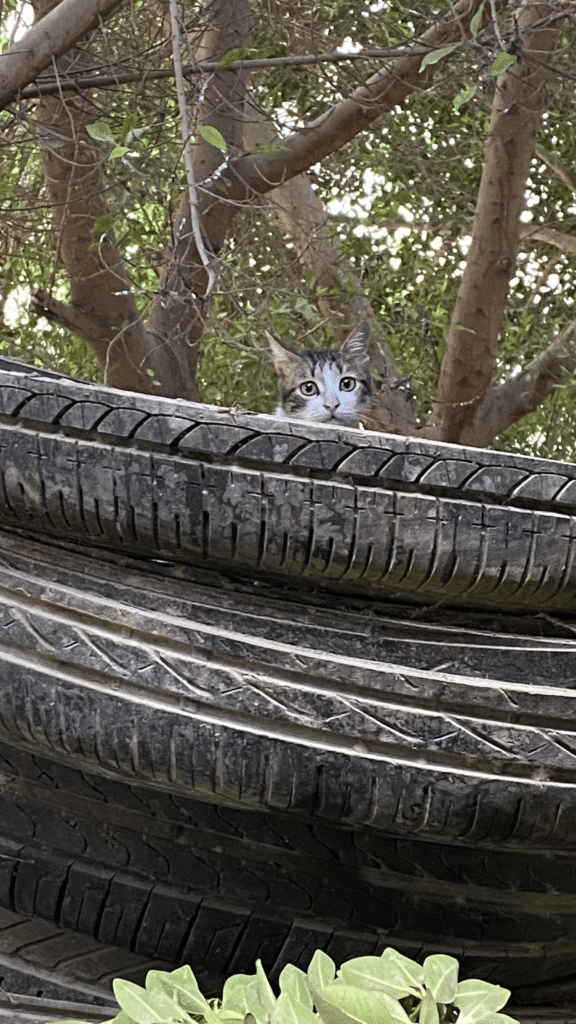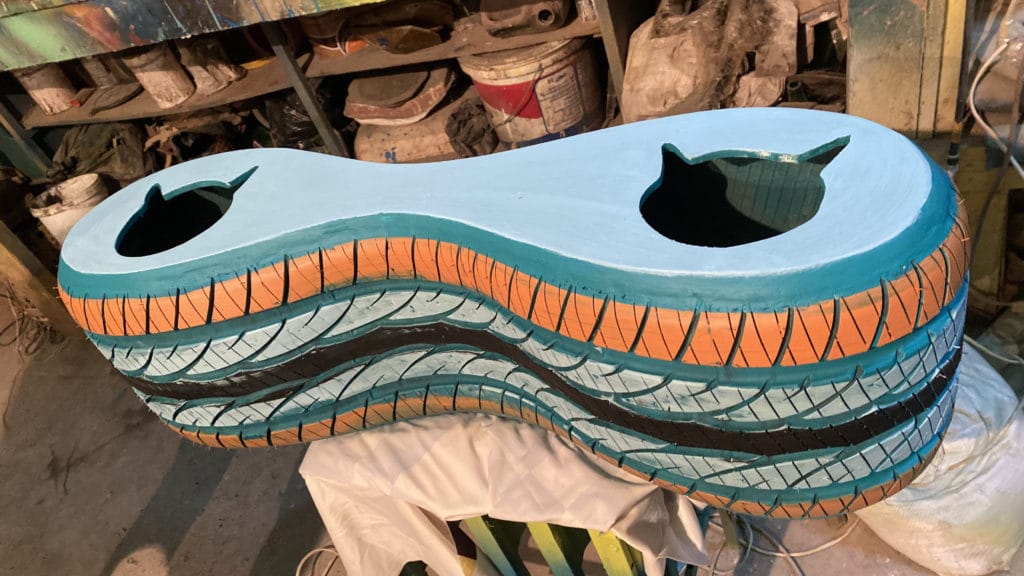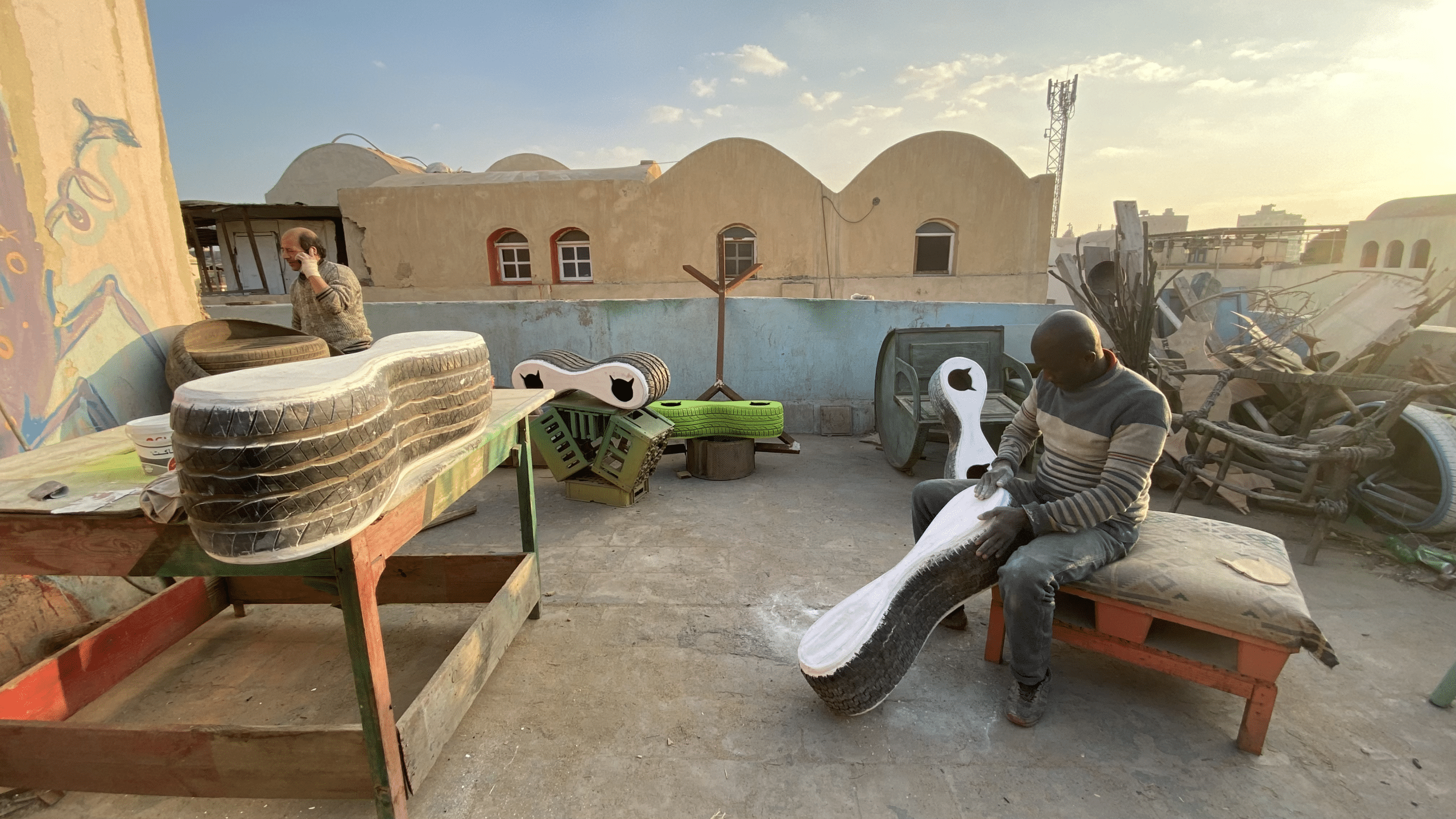Stray cats in Cairo have new saviours in Egyptian designer duo Ibrahim Abougendy and Aly Zeineldin who craft used tires into functional homes for them.
Topline
Eco-friendly products designer Ibrahim Abougendy and Aly Zeineldin, the owner of e-commerce platform Petman, teamed up to create Sheltire, a non-for-profit product using upcycled tires as shelter for stray cats in Cairo, Egypt.
Background
“We’re crazy artists,” says Ibrahim Abougendy, also known as ‘trash designer’ in the North African country. He goes into the street on his daily route to his studio, Mobikya, stopping for coffee at a café, and sees problems he wants to turn into designs.
Cats roam the Mobiyka studio, using Sheltire as shelter. “The cats live there, but they come and go,” Abougendy says. Mobikya creates mass-producible solutions for solid waste and eco-friendly products out of sustainable materials.
Abougendy noticed that during winter cats would crawl under old cars in Egypt, endangering their lives. The cats also used felled trees as lodging. So the idea for a shelter for cats was born, but wouldn’t see fruition until this year.
“Our goal was to create a functional/economic mobile shelter unit that could fit in an urban context and save street cats from the extreme climate conditions we have seen hitting Egypt the past couple of winters. It even began to snow in southern regions like Hurghada,” Abougendy says.
“We did this because we saw something wrong happening and we had a solution. We just let it flow and let people interact with it. What happened is a storm we didn’t expect.”
It took two years to find the right design meant for a cat’s anatomy and make it ergonomic. Abougendy finally hit on the infinity shape. Now they can stack tires on top of each other, creating hostels for up to 200 cats.

“We did this because we saw something wrong happening and we had a solution. We just let it flow and let people interact with it. What happened is a storm we didn’t expect,” he says.
Abougendy proposed the idea of a cat shelter to Zeineldin, saying the design would be mass producible, but not for sale, rather as a CSR initiative. Together, they took a risk, and it has paid off: Sheltire went viral on the internet.
Sheltire is an open-source design, deceptively simple in appearance, but difficult to pull off.
Abougendy says people from Canada and the Gulf have tried to duplicate the design, and says he’s happy to help. “It may look easy to fabricate, but it’s not. We do intensive research and development on every product.”
He has also fine-tuned the prototype with extra insulation for warmth.
From 2017, Abougendy and Zeineldin have been working together, creating an e-commerce store called Knum; the name inspired by Khnum/Khnemu, an ancient Egyptian god of fertility associated with water and procreation.
The two also make tables, sound systems, lamp shades, basins, shelves, mirrors, chairs and more using composite designs of upcycled tires and washing machine parts. All are curated for mass production.
Oil drums were another favorite for Abougendy, and he converted 500 dumped barrels into useful designs and products for the Maker Faire Cairo in 2018.
In 2020, they also began a line of eco-friendly pottery products. The Ahy mug is unique – the dregs from the coffee/tea remain in the cup because of its circular design. Ahy means ‘wavy’ in hieroglyphics. Zeineldin says they are trying to revive ancient Egypt’s designs.

“There’s no tendency in Egypt to buy eco-friendly products just for the sake of being sustainable. They buy things for the functionality,” Abougendy adds.
“When ancient Egyptians designed anything, they used bio-mimicry, they looked to nature. When they designed things like columns, they looked to the Nile. So they have a leaf-bundle column for example, and I am inspired by that,” Abougendy says.
He implements the column designs in his work, looking for ergonomic solutions that visually remind one of ancient Egypt.
“We do ready-made art. What we do is next level though. We think functionality first – so tires are elastic and insulated in a way – then we do the architecture side. And we merge different materials so we have advanced functionality. Upcycling is transferring a tire into a table, so you upgrade its economic unit value,” Abougendy explains. He goes on to say the composite designs merging materials make their designs unique.
Tangent
The duo say stray cats are mostly ignored in Egypt and while some people feed them, there are still instances of animal cruelty, particularly against dogs. In 2017, Abougendy adopted a dog he found in old Cairo, named Coco, but after two years, she died of poisoning. His second dog, Basbousa (named after an Arabic dessert), now lives happily in a larger space with friends.
Zeineldin could not find quality food for his Ridgeback dog Gamila (meaning ‘beautiful’ in Arabic) and set out to create an online store called Petman to meet this need. Petman partnered with the Animal Protection Foundation, delivering subscription meals for dogs. He says it wasn’t for the money, rather for a cause. Abougendy proposed the cat shelter as another initiative.
The Sheltire for cats is a non-profit product, only taking into account the cost of construction and labor. Definitely something to purr about.

